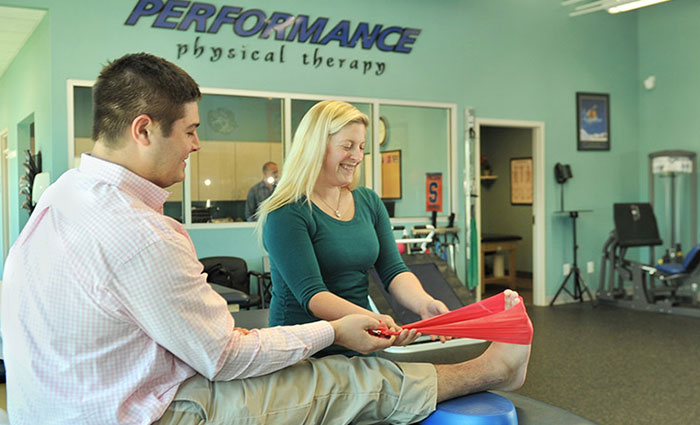Sometimes surgery is the only way to treat a bone or joint issue related to an injury, degenerative condition or other dysfunction. However, most orthopaedic doctors will recommend treatment with a physical therapist as an initial course of action, because it is the least intrusive approach to healing. In many cases, strengthening muscles around the joint and expanding range of motion will do the trick to eliminate pain and restore movement.
A physical therapist is a trained and licensed medical professional with experience in diagnosing physical abnormalities, restoring physical function and mobility, maintaining physical function, and promoting physical activity and proper function – according to the American Physical Therapy Association (APTA). Licensed physical therapists can be found in a wide range of healthcare facility settings, including at Cary Orthopaedics’ locations in Cary, Morrisville and Holly Springs.
A physical therapist can care for patients during all stages of healing. PT can be beneficial for many types of injuries and conditions to help ease pain and facilitate recovery. Below are just a few benefits of physical therapy:
Reduce or eliminate pain
Experiencing acute pain or living with chronic pain can be very frustrating, especially if the cause of the pain is unknown. Physical therapy has been proven to ease pain through therapeutic exercises and manual therapy techniques by mobilizing the joint and soft tissue and restoring muscle function. Therapists also use specialized treatments like ultrasounds, taping, electrical stimulation and dry needling to help reduce pain and restore muscle and joint function.
Restore mobility
Many patients experience difficulting standing, walking and balancing after an injury or surgery. If the joint is static for too long, it can become stiff and limited in its range of motion. Physical therapy can help patients get back on their feet by increasing mobility. Physical therapists provide stretching and strengthening exercises to help patients regain strength and coordination, preventing falls and further injuries. Therapists can also properly fit patients with crutches, canes, walkers and other assistive devices.
Avoid surgery
While “going under the knife” is unavoidable for some orthopaedic ailments, PT can be an excellent alternative in many cases. Conditions such as meniscal tears, knee osteoarthritis, spinal stenosis, rotator cuff tears and degenerative disk disease can often be treated effectively with physical therapy, allowing the patient to avoid invasive surgery.
Recover from injury with a physical therapist
If you have recently suffered from a sports injury or undergone surgery, physical therapy can help your body heal faster. Physical therapists create specific recovery programs for each individual patient, keeping their strengths and weaknesses in mind. These customized recovery programs will ensure a safe return to your sport or normal daily activities.
Prevent injury
Just as physical therapy can help you recover from an injury, it can also help prevent injuries in the first place. A physical therapist will identify muscle or skeletal weakness for each patient, using that information to understand how a patient will likely suffer from an injury. They will then build a strengthening program that specifically targets weaknesses to strengthen areas that can help prevent injury.
Counteract the effects of aging
Physical therapy helps address bone, joint and muscles issues that come with aging – such as arthritis, chronic joint pain and osteoporosis. Older patients often appreciate the safe and guided approach of a physical therapist for managing these issues.
Address other health concerns
In addition to physical therapy for orthopaedic injuries and conditions, specialized PT can help with many other health problems, including cardiovascular disease, respiratory ailments and diabetes. Your general practice physician, cardiologist or other specialist can advise you on when therapy is appropriate for these concerns.
When to see a physical therapist
Patients are not required to see a doctor before seeking physical therapy treatment. Individuals should consider the cause, intensity and nature of the pain they are experiencing, and schedule either a PT or doctors appointment accordingly. Depending on the particular case, the physical therapist may refer the patient directly to a doctor, or he/she may work with the patient in a series of PT sessions to see if the issue can be resolved with therapy alone.
Find a physical therapist in the Triangle
Cary Orthopaedics Physical Therapy offers top-rated, comprehensive physical therapy, occupational therapy and rehabilitation services. Working closely with our physicians, our PT team makes your full recovery our number one goal. With multiple, convenient Triangle locations, Cary Orthopaedics Physical Therapy can help you get back to living a pain-free life!






